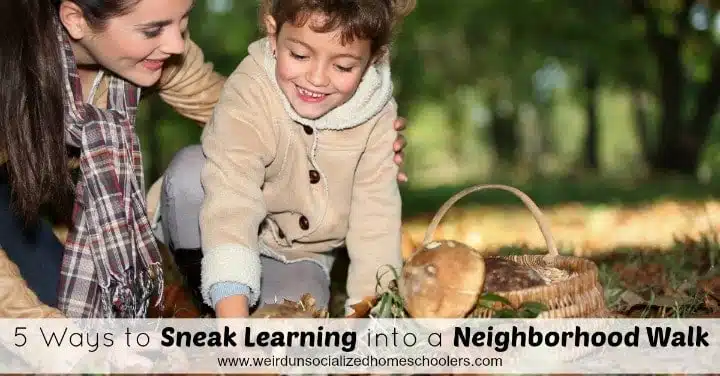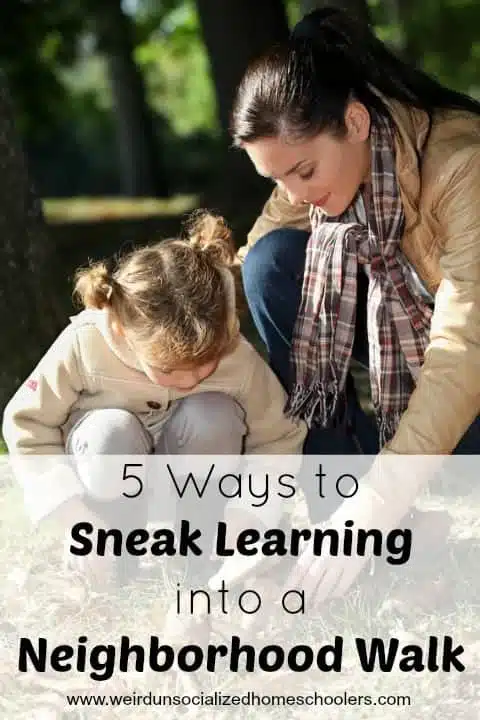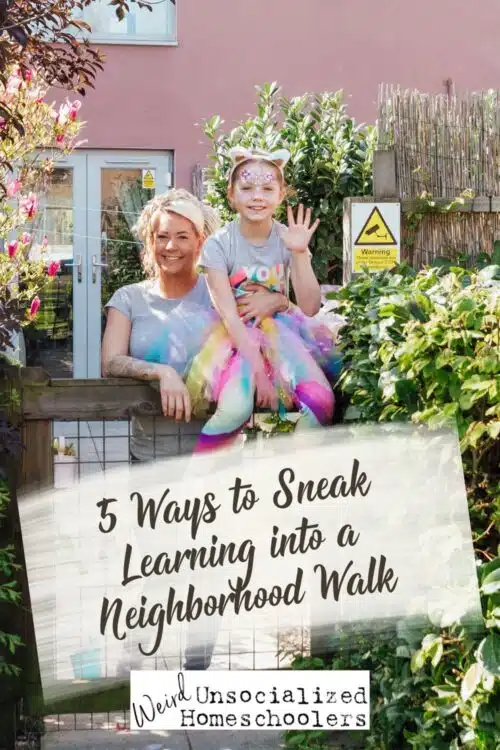5 Ways to Sneak Learning into a Neighborhood Walk
The weather has been so pleasant lately that we have wanted to spend as much time outdoors as possible. My six-year-old nephew spent a few days with me recently. One evening after dinner, we spent some time walking around my neighborhood. I was able to sneak learning into our walk simply by noticing and discussing the things around us.

Next time you take your young children on a walk around the neighborhood, see if you can naturally introduce some of these ideas. Your kids will have so much fun they won’t even realize they’re learning.
Math
Have your child look for items of a particular color or number. Can he find a red car or three flowers?
Talk about size as you look at the things around you. Ask your child to look for an item that is smaller than he is. Or, find something that is larger than his hand. That leaf is big. Can he find one that is bigger?
Distance is another topic you can discuss. Use the words near and far as you describe things you see around the neighborhood. The dog is near the fence, and the creek is far away.
Reading
Have your child look for letters on street signs and mailboxes as you walk around the block. She may want to look at letters on license plates or work truck logos, as well.
If your child can already identify her letters, you could ask her to find something that starts with a certain sound or find things that rhyme – tree and bee, cat and hat.
Science
Science is so easy to teach as you walk around the block. Kids are fascinated by what they see around them. Point out the color of the sky and the shape of the clouds. Talk about animals you see and hear or insects that are flying by. Identify flowers and trees in a neighbor’s yard.

Social Studies
Does your child understand that the world is bigger than he can see? Start by discussing where you live. Teach him your address and show him the name on your street sign.
Once he’s got that down, explain that your street is part of a bigger city. Then, the city is part of a larger state, and the state is part of a bigger country.
These concepts may be more than your child can understand, but it’s important to plant seeds of knowledge that he can build on as he gets older.
Vocabulary
Use specific names for items you see on your next walk around the neighborhood. Teach your child the real name for things. It’s not just a flower; it’s a tulip. That dog is a Husky. The neighbor’s tree is an oak tree.
This specific naming helps young children expand their vocabulary and helps them begin to see differences in the things around them.
What is your favorite way to sneak in a little learning as you walk around the neighborhood with your kids?
Tara is wife to Matt and homeschool momma of three. Her children are 21, 16, and 11 – two boys and one girl. She is currently homeschooling her daughter – 6th grade. When she’s not blogging, Tara enjoys crocheting and snuggling up with a good book. She and her family recently moved from Texas to Ohio, and they’re having fun exploring their new surroundings. She blogs about homeschooling, motherhood, and family life on both of her blogs – Homeschool Preschool and Teaching with Children's Books.








Last year my daughter (who loves to invent games) was inspired by a Wild Kratt’s episode to go on a “Food Web Scavenger Hunt.” Before we left the house, we each chose something from the different levels: Producers (i.e. grass), Primary Consumer/Herbivore (i,e. grasshopper), Secondary Consumer/Predator (i.e. squirrel), and so on. We each tried to find an example of our picks in order before the other person did.
Another thing we’re doing this year is a 4 seasons exploration. I wrote about it on my blog: https://dianeballardsmith.com/exploring-creation-four-seasons-project/